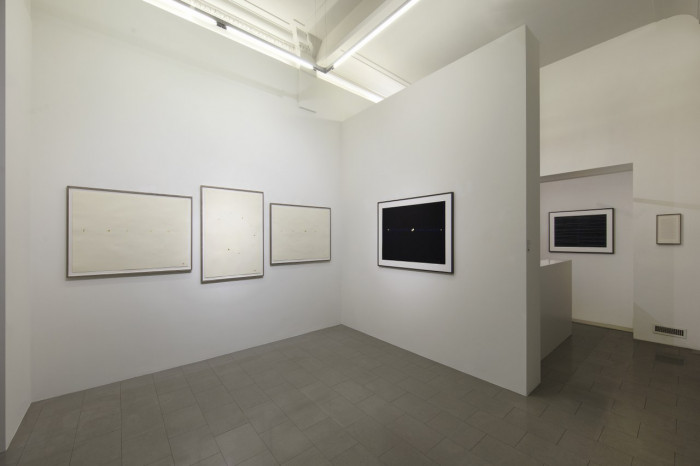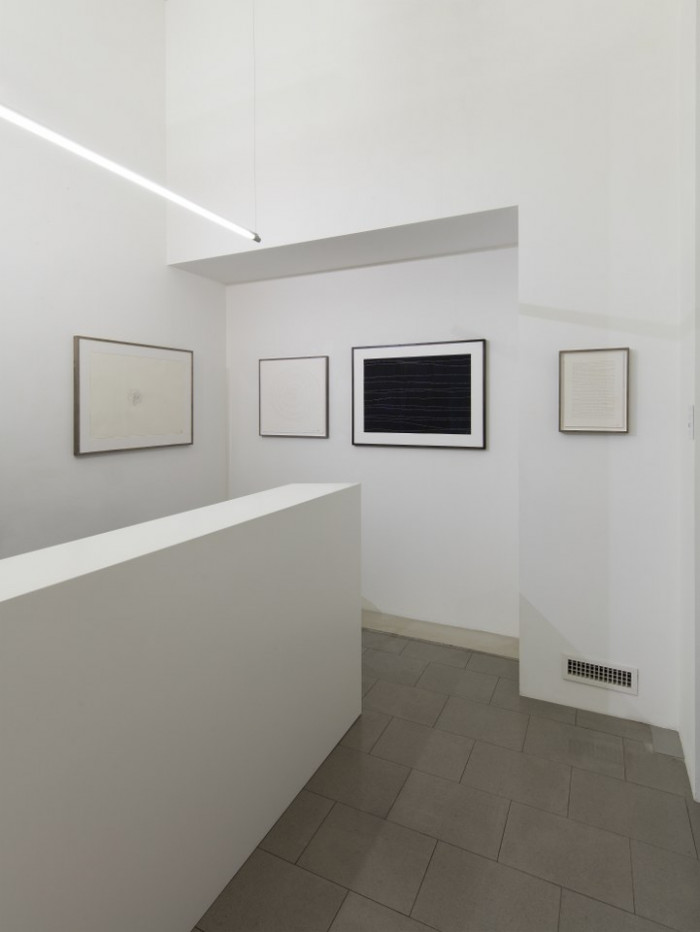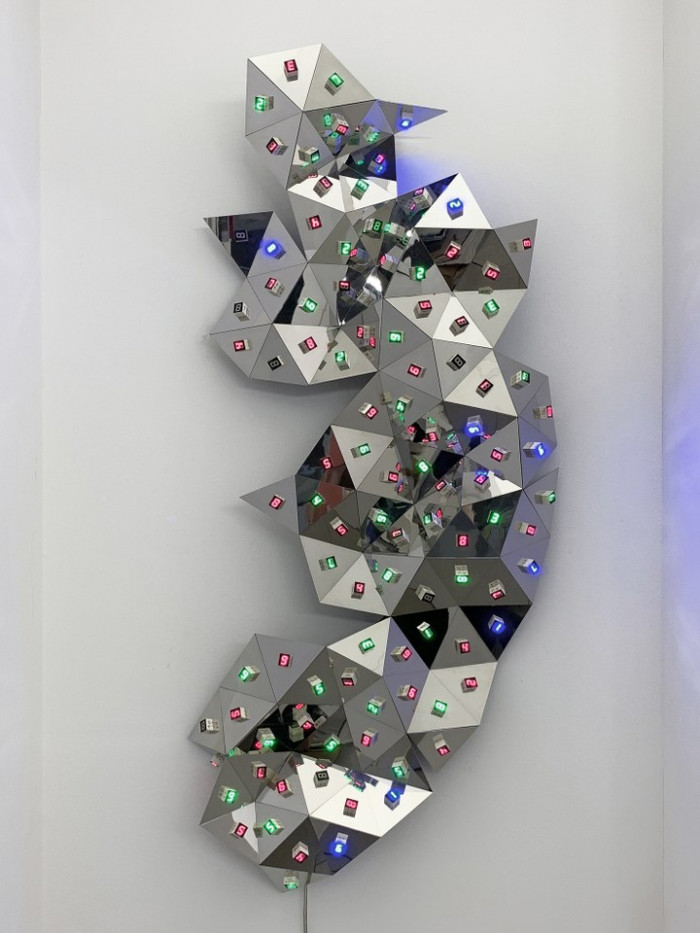Tatsuo Miyajima Opere su carta 1995-2018
The exhibition space Buchmann Lugano presents Saturday February 2nd starting from 5 pm the first solo show of drawings in Switzerland by the Japanese artist Tatsuo Miyajima (Tokyo, *1957).
The series of works on paper here presented were made between 1995 to 2018 and explore several issues essential to Tatsuo Miyajima‘s work.
“Kũ” Drawing Series
In the Zen tradition Kũ stands for emptiness (Kũ is the transcription of the Sanskrit word sunya or sunyata, translated literally as “emptiness“). The artist describes how he produced these drawings in a state of Kũ, holding a pencil in his hand, his eyes closed: “The lines from my subconscious show my time spent in emptiness. The length of time given in the title, 15 minutes for example, describes the period of time which I spent in an altered state of mind, with my eyes closed”.
“Innumerable Counts” Series
Every number in these drawings represents a moment in the counting cycle from 9 to 1. The empty space in the potentially in infinite sequence of numbers re- presents the figure zero, which does not appear in his work. In these drawings the artist is attempting to grasp moments in cycles of innumerable counts. The Innumerable Counts series visualize life for Tatsuo Miyajima. The spirals or lines in the drawings are thus excerpts from a broader context, from innumerable moments in time.
“Count Down” Series
Tatsuo Miyajima provides a different interpretation of the zero, the empty space, in his Count Down Drawing Series: this series of works shows a repeated sequence, counting down from 9 to 1, as the title suggests. Here, too, the place of zero (Kũ) is represented by an empty space or filled with a thin gold foil or a microchip. In this variation the empty space is filled; it is, as the artist points out, the field provided with every possibility, the field of potential.
The Miyajima’s works on paper are an essential component of his practice, seen as equal in status to the installation pieces and sculptures. They complete the artist‘s complex œuvre, which is characterized by investigation into the significance of counting and time, and by subtle meditations exhibiting sublime precision and finesse.
Tatsuo Miyajima is one of the most important Japanese living artist, many of his works are in prestigious museum collections such the Tate Gallery London, the Bayerische Staatsgemäldesammlung München, the Caixa Barcelona, the Deste Foundation in Athens, the Museum of Contemporary Art Chicago, the Museum of Contemporary Art Tokyo, Leeum Seoul, Kunstmuseum Bern, Kunstmuseum St.Gallen and the M + in Hong Kong.
For further informations:
Buchmann Lugano
Via della Posta 2, CH-6900 Lugano
Da martedì a venerdì 13.00 – 18.00; sabato 13.00 - 17.00 buchmann.lugano@bluewin.ch www.buchmanngalerie.com
Lo spazio espositivo Buchmann Lugano presenta sabato 2 febbraio a partire dalle ore 17.00 la prima mostra personale in Svizzera dedicata ai disegni dell’artista giapponese Tatsuo Miyajima (Tokyo, *1957).
Le opere su carta qui presentate sono state realizzate tra il 1995 e il 2018 ed esplorano diverse questioni essenziali del lavoro di Miyajima.
Serie di disegni “Kũ”
Nella tradizione Zen Kũ rappresenta la vacuità (Kũ è la trascrizione della parola sanscrita sunya o sunyata, tradotta letteralmente come "vacuità"). L’artista descrive la realizzazione di questi disegni in uno stato di Kũ, con una matita in mano e gli occhi chiusi: “ Le linee arrivano dal mio subconscio e mostrano il tempo che ho passato nel vuoto. Il periodo di tempo indicato nel titolo, ad esempio 15 minuti, descrive il momento trascorso in uno stato mentale alterato, con gli occhi chiusi”.
Serie di disegni “Innumerable Counts”
Ogni numero in questi disegni rappresenta un momento nel ciclo di conteggio da 9 a 1. Lo spazio vuoto nella sequenza potenzialmente infinita di numeri rappresenta lo zero che non appare mai nel suo lavoro. In questi disegni l'artista tenta di cogliere momenti in cicli di innumerevoli conteggi. La serie Innumerable Counts rappresenta per Tatsuo Miyajima la vita. Le spirali o le linee in questi disegni sono quindi estratti da un contesto più ampio, da innumerevoli momenti nel tempo.
Serie di disegni “Count Down”
Tatsuo Miyajima fornisce una diversa interpretazione dello zero, lo spazio vuoto, nella serie di disegni Count Down: questi lavori mostrano una sequenza ripetuta, con un conto alla rovescia da 9 a 1, come suggerisce il titolo. Anche qui, il punto zero (Kũ) è rappresentato da uno spazio vuoto o riempito con una sottile lamina d'oro o un piccolo microchip. In questa variazione lo spazio vuoto è colmato; è, come sottolinea l'artista, il campo dotato di ogni possibilità, il campo del potenziale.
Le opere su carta di Miyajima sono una componente essenziale della sua pratica artistica al pari delle sculture e installazioni. I disegni completano infatti la complessa opera dell'artista caratterizzata dall'indagine sul significato del conteggio numerico e sulla nozione di tempo, grazie a sottili meditazioni di una sublime finezza e precisione.
Tatsuo Miyajima è uno dei più importanti artisti giapponesi viventi, molte sue opere si trovano in rinomate collezioni museali quali la Tate Gallery di Londra, la Bayerische Staatsgemäldesammlung München, la Caixa di Barcellona, la Fondazione Deste di Atene, il Museum of Contemporary Art di Chicago, il Museum of Contemporary Art di Tokyo, il Leeum Seoul, il Kunstmuseum Bern, il Kunstmuseum di St.Gallen e il M + di Hong Kong.
Per maggiori informazioni:
Buchmann Lugano
Via della Posta 2, CH-6900 Lugano
Da martedì a venerdì 13.00 – 18.00; sabato 13.00 - 17.00 buchmann.lugano@bluewin.ch www.buchmanngalerie.com
Tatsuo Miyajima
Born 1957 in Tokyo. Lives and works in Ibaraki, Japan.
2012 - 2016 Kyoto University of Art & Design Vice President
2006 - 2016 Tohoku University of Art & Design Vice President
| 1986 | Completed postgraduate studies at Tokyo National University of Fine Arts and Music (M.A.) |
| 1984 | Graduated from Oil Painting Course, Fine Arts Department, Tokyo National University of Fine Arts and Music (B.A.) |
| 1998 | London Institute honorary doctorate |
| 1993 | Fondation Cartier pour l'art contemporain, Paris |
| 1990–1991 | DAAD Scholarship Berliner Kunstprogramm Berlin, |
| 1990 | ACC - Asian Cultural Council, New York |
National Museum of Modern Art, Kyoto, Japan
Hara Museum of Contemporary Art, Tokyo, Japan
Museum of Modern Art, Shiga, Japan
Nagoya City Art Museum, Nagoya, Japan
Museum of Contemporary Art, Tokyo, Japan
Panasonic Museum in Osaka, Japan
FARET Tachikawa, Tokyo, Japan
TV Asahi building, Tokyo, Japan
Tokyo Opera City, Tokyo, Japan
Chiba City Museum, Chiba, Japan
Group Home Sala in Florence Village, Akita, Japan
The Museum of Modern Art, Saitama, Japan
Contemporary Art Museum, Kumamoto, Japan
Toyota Municipal Museum of Art, Aichi, Japan
Saitama Prefectural University, Saitama, Japan
Izumi City Plaza, Osaka, Japan
Naoshima Contemporary Art Museum, Kagawa, Japan
Iwaki City Art Museum, Fukushima, Japan
Hiroshima City Museum of Contemporary Art, Hiroshima, Japan
M+ Museum, Hong Kong
Taipei Fine Arts Museum, Taiwan
Samsung Cultural Foundation, Seoul, Korea
Leeum, Samsung Museum, Seoul, Korea
Chinese Telecom, Taipei, China
Tate Gallery, London, UK
The British Museum, London, UK
Deste Foundation for Contemporary Art, Athens, Greece
Fondation Cartier pour l'art contemporain, Paris, France
Kunstmuseum Bern, Bern, Switzerland
Kunstmuseum St. Gallen, Switzerland
Université de Genève, Switzerland
La Caixa, Barcelona, Spain
Pinakothek der Moderne, Munich, Germany
Kunstmuseum Stuttgart, Germany
Fondazione TESECO per l'Arte, Pisa, Italy
Chateau La Coste, Aix-en-Provence, France
Modern Art Museum of Fort Worth, Texas, U.S.A.
San Francisco Museum of Modern Art, San Francisco, U.S.A.
Museum of Contemporary Art, Chicago, U.S.A.
Dallas Museum of Art, U.S.A.
Denver Art Museum, Denver, U.S.A.
Dannheisser Foundation, New York, U.S.A.
National Gallery of Canada, Ottawa, Canada
Oakville Galleries, Oakville, Canada
Australian Museum, Sydney, Australia
| 2005 | ARTISTS SUMMIT, KYOTO, Kyoto University of Art and Design, Kyoto, Japan |
| 2002 | Collaboration with SOPHNET (fashion design brand) 2002 A/W Collection Tokyo 1000 Real Life Project - Death Clock, Tokyo |
| 2000 | Floating Time - Hospice Project, Sotoasahikawa Hospital, Akita |
| 1998 | Portfolio for The Edge of Awareness |
| 1995 | Portfolio for 4. Uluslararasi Istanbul Bienali-ORIENT / ATION |
| 1994 | Mirror, multiple, Spiral, Tokyo |
| 1993 | Over Economy, acrylic, pencil on bank note \10,000 |
| 1992 | Project for PARKETT |
| 1984 | Time Funeral, record jacket, SMS Records |












